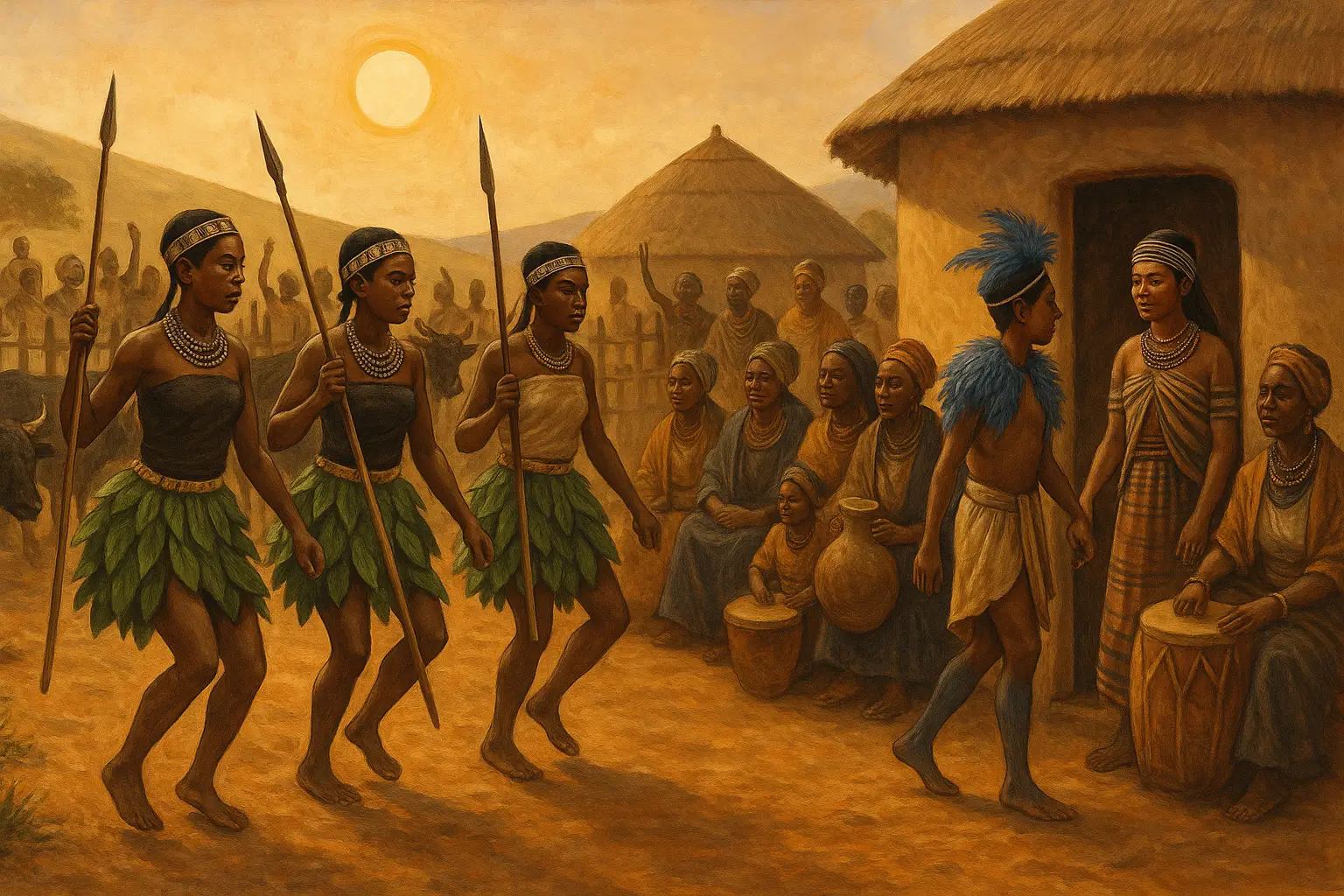Long, Long Ago...
Long, long ago, when the voices of the ancestors still whispered through the grass, and when the blue crane’s feather was worn only by the brave, there lived a chief whose daughter was as beautiful as the morning star. Her laughter was like rain after drought, and her eyes held the calm of deep water. Yet she was willful, and her heart did not always bow to the customs of her people.
In those days, every girl of the Amaxhosa, when she came to the time of womanhood, was kept apart in her aunt’s hut, hidden from the eyes of men. This time was called the Ntonjane the dance of coming forth the great celebration when a child became a woman.
Messengers would go forth to every kraal, calling the young maidens to gather. From hills and valleys they came, singing as they walked, their songs carrying on the wind long before their feet touched the village ground. The first group to arrive waited before the cattle kraal, and others joined them until the air was alive with music.
The Dance of the Maidens
When all had gathered, the girl’s father the master of the feast chose an ox to be slaughtered, and the smell of roasting meat filled the air. The women dressed the girls for the dance. They wore only a girdle and a small apron made of green leaves the cacawe which rustled softly when they moved. In their hands they held assagais, not for war, but as emblems of strength and grace.
Then the drums began. Four maidens stepped forward to dance while the others sang. When they tired, four more took their place, until every girl had danced beneath the eyes of her people. The crowd watched closely, clapping, singing, and shouting praises to the best dancers. If they could not agree, the girls danced again until the people’s hearts beat as one in choice.
After the maidens, the men and women took their turn, standing in long lines as the dust rose about their feet. The songs grew deeper, the rhythm stronger. They danced until the sun sank behind the hills, painting the kraal red and gold. When night came, the guests went home, leaving behind only the girls of the jaka, who stayed to keep the sacred watch.
Days of Celebration
At dawn, the dancing began again. If the girl’s father was wealthy, three oxen were slaughtered, and the celebration lasted twelve days. But if she was the daughter of a chief as in this story it continued for twenty-four days and nights. From every kraal, oxen were sent for feasting, for no one must go hungry while a daughter of power was becoming a woman.
On the twenty-fourth day, when the sun rose pale through the morning mist, the girl came out of her seclusion. The son of her father’s chief councillor entered her hut, wearing upon his head the two wings of a blue crane indwe the mark of bravery, worn only by those who had faced the spears of battle. He walked before her, and she followed him, her mother and the maidens of the jaka behind, singing the ancient songs.
The people gathered. Cattle were slaughtered for the indwe, the horns sounding through the valley. Then the girl drank milk for the first time since her seclusion began. The milk was brought in great skins from every kraal, poured into a vessel of rushes. A little was spilled upon the hearth in offering to the ancestors. Her aunt, who had watched over her, took the first sip. Then the girl drank, and the people cheered, for now she was a woman.
She was led to her mother’s hut, and the people danced one last time. When the sun leaned westward, they went back to their homes, the songs still trailing behind them on the wind. Thus ended the Ntonjane.
The Chief’s Daughter Who Disobeyed
But the daughter of this chief the one whose beauty was like light on still water — did not obey the custom. She scorned the seclusion, disobeyed her father, and mocked the sacred dances. She stepped out before her time, and the elders shook their heads. “A woman who does not honor Ntonjane,” they said, “is like an unripe fruit plucked too soon sweet to look upon, but bitter to taste.”
Yet fate is a strange dancer. When the time of stories came, it was said that a young chief saw her and loved her at once. Though she had defied custom, he took her for his wife. And so, as in the tales told by both black and white, the girl who walked her own path married the prince.
The elders still asked, “What virtue did she show to earn such favor?” But the storytellers only smiled and said, “Perhaps it was not her virtue, but her spirit. For even among the daughters of chiefs, the heart has its own way.”
After the Dancing
The Ntonjane was sacred a time of transformation and feasting, of beauty and temptation alike. For during those nights, the maidens of the jaka were free by old custom to choose sweethearts as they pleased. The elders turned their eyes away, for such had always been the way of things.
And so, the festival that began in purity sometimes ended in passion. Yet it was not the task of the storyteller to judge only to tell what was. For the Amaxhosa said:
“The river does not ask why it flows; it simply follows its path to the sea.”
